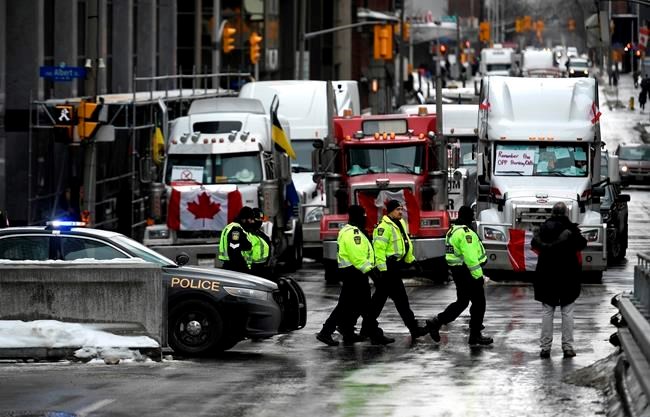OTTAWA — The sanctuary at St. Andrew's Presbyterian Church in downtown Ottawa was "brutally altered" during the "Freedom Convoy," the church's administrator told the criminal trial of two of the protest's organizers on Thursday.
Vivian Leir told the court she was overwhelmed by the trucks surrounding the church when big rigs and other vehicles arrived in Ottawa to protest COVID-19 public health measures last year.Â
She said the usually quiet and serenelimestone church down the street from Parliament Hill was infiltrated by horn honking, diesel fumes and the sound of Led Zeppelin playing loudly outside.
"They were fouling it," Leir said of the church, which was built in 1874.Â
She is one of five Ottawa residents expected to testify in the criminal trial of protest organizers Tamara Lich and Chris Barber, who face charges of mischief and counselling others to commit mischief and intimidation for their role in the massive demonstration.
None of the witnesses the court heard from on Thursday dealt directly with Lich or Baber.Â
Leir called the protest an occupation.
"Was our space being invaded and taken over? Yes," she said when challenged by the defence. "I feel it was an occupation."
Leir raised her voice in court as she described protesters urinating on the church grounds, putting clothes on a statue of Jesus and covering church signs with protest signs. One of the signs left on the church property included an expletive directed at Prime Minister Justin Trudeau.Â
She said she was sworn at when she confronted protesters for urinating or playing loud music outside the church.
Leir said she arranged for a police escort so the church's minister could deliver services, though few people attended. Choir practices and other meetings were cancelled, deliveries were missed and the church had to refund groups that had rented space in the building.
Protesters remained encamped in the streets of Ottawa for three weeks, sparking local, provincial and national states of emergency.
Downtown Ottawa resident Stephane Bellfoy testified that the traffic from parked trucks seriously affected his commute at times during the protest.Â
His drive to the Ottawa suburb of Blackburn Hamlet, which typically took 20 minutes, took an hour and a half at one point, he said in French through an interpreter.
He recalled that on one night, traffic was at such a standstill downtown that his son had to walk 1.5 kilometres home from the rink wearing skates and full hockey gear.
The sound of honking horns was "incessant" and "intolerable," another local resident, Sarah Gawman, told the court.
She said she lived on an upper floor of a highrise condo building in downtown Ottawa when the protest began last year, and trucks and other vehicles lined up in her neighbourhood "as far as the eye could see."
She told the court that even with the windows closed, she heard drumming, honking, engine revving and fireworks into the early hours of the morning.
"I wasn't able to sleep. I wasn't able to sit in my front room," she told the court.Â
She was ordered to work from home, and said she wasn't able to get to a medical appointment because the cab company she called to pick her up refused to come.
"The buses were rerouted, so that wasn't going to be a possibility," she said.
"It's too far for me to walk."
Gawman's testimony was punctuated by objections from the defence, as her evidence strayed from her observations during the convoy to the ways the protest affected her personally.Â
"It's OK, I have my running shoes on," Gawman joked on her third trip from the witness box to the hallway as the lawyers rose to argue about her testimony.
The Crown intends to call five local residents as part of its case, as well as a representative of the National Arts Centre and an employee at OC Transpo, the local public-transit operator.Â
The Crown says it plans to ask the Ottawa witnesses about the turmoil they observed during the protest, in an effort to tie disruptions to Lich and Barber.
One of the anticipated witnesses is Zexi Li, the lead plaintiff in a proposed class-action lawsuit against the organizers on behalf of people who live and work in downtown Ottawa.
Gawman told the court she is also a plaintiff in the lawsuit, and Leir said she registered on behalf of the church.
Under cross-examination, she said she was physically able to walk the streets if she wanted to, and was physically able to get to her office.
Barber's lawyer Diane Magas suggested she may have been exaggerating when it came to how often the horns were honking, since there are several videos from the convoy that don't feature any horn honking.Â
Magas asked whether Gawman saw people at the protest wearing Canadian flags who were jovial.
"Some were, and some weren't," she said.Â
Bellfoy is expected to continue his testimony Friday.Â
This report by The Canadian Press was first published Oct. 12, 2023.
Laura Osman, The Canadian Press




